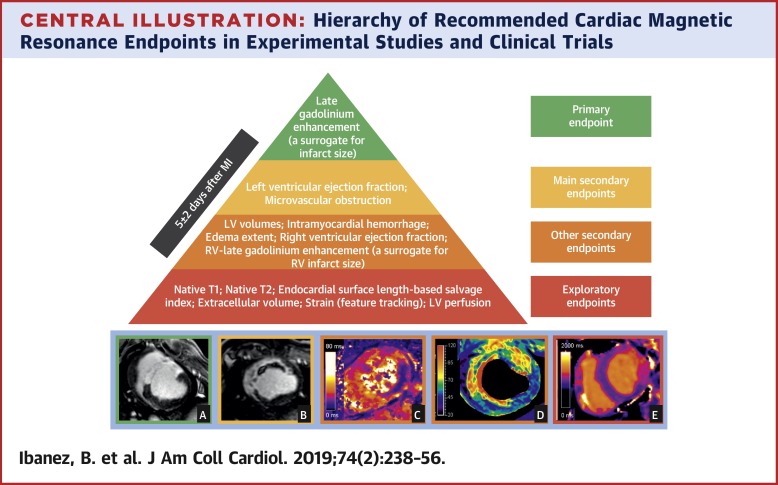当前位置:
X-MOL 学术
›
J. Am. Coll. Cardiol.
›
论文详情
Our official English website, www.x-mol.net, welcomes your
feedback! (Note: you will need to create a separate account there.)
Cardiac MRI Endpoints in Myocardial Infarction Experimental and Clinical Trials
Journal of the American College of Cardiology ( IF 21.7 ) Pub Date : 2019-07-01 , DOI: 10.1016/j.jacc.2019.05.024 Borja Ibanez 1 , Anthony H Aletras 2 , Andrew E Arai 3 , Hakan Arheden 4 , Jeroen Bax 5 , Colin Berry 6 , Chiara Bucciarelli-Ducci 7 , Pierre Croisille 8 , Erica Dall'Armellina 9 , Rohan Dharmakumar 10 , Ingo Eitel 11 , Rodrigo Fernández-Jiménez 12 , Matthias G Friedrich 13 , David García-Dorado 14 , Derek J Hausenloy 15 , Raymond J Kim 16 , Sebastian Kozerke 17 , Christopher M Kramer 18 , Michael Salerno 18 , Javier Sánchez-González 19 , Javier Sanz 20 , Valentin Fuster 20
Journal of the American College of Cardiology ( IF 21.7 ) Pub Date : 2019-07-01 , DOI: 10.1016/j.jacc.2019.05.024 Borja Ibanez 1 , Anthony H Aletras 2 , Andrew E Arai 3 , Hakan Arheden 4 , Jeroen Bax 5 , Colin Berry 6 , Chiara Bucciarelli-Ducci 7 , Pierre Croisille 8 , Erica Dall'Armellina 9 , Rohan Dharmakumar 10 , Ingo Eitel 11 , Rodrigo Fernández-Jiménez 12 , Matthias G Friedrich 13 , David García-Dorado 14 , Derek J Hausenloy 15 , Raymond J Kim 16 , Sebastian Kozerke 17 , Christopher M Kramer 18 , Michael Salerno 18 , Javier Sánchez-González 19 , Javier Sanz 20 , Valentin Fuster 20
Affiliation

|
After a reperfused myocardial infarction (MI), dynamic tissue changes occur (edema, inflammation, microvascular obstruction, hemorrhage, cardiomyocyte necrosis, and ultimately replacement by fibrosis). The extension and magnitude of these changes contribute to long-term prognosis after MI. Cardiac magnetic resonance (CMR) is the gold-standard technique for noninvasive myocardial tissue characterization. CMR is also the preferred methodology for the identification of potential benefits associated with new cardioprotective strategies both in experimental and clinical trials. However, there is a wide heterogeneity in CMR methodologies used in experimental and clinical trials, including time of post-MI scan, acquisition protocols, and, more importantly, selection of endpoints. There is a need for standardization of these methodologies to improve the translation into a real clinical benefit. The main objective of this scientific expert panel consensus document is to provide recommendations for CMR endpoint selection in experimental and clinical trials based on pathophysiology and its association with hard outcomes.
中文翻译:

心肌梗塞实验和临床试验中的心脏 MRI 终点
再灌注心肌梗死 (MI) 后,会发生动态组织变化(水肿、炎症、微血管阻塞、出血、心肌细胞坏死,并最终被纤维化替代)。这些变化的范围和程度有助于心肌梗死后的长期预后。心脏磁共振 (CMR) 是无创心肌组织表征的金标准技术。CMR 也是在实验和临床试验中识别与新的心脏保护策略相关的潜在益处的首选方法。然而,实验和临床试验中使用的 CMR 方法存在广泛的异质性,包括 MI 后扫描的时间、采集协议,以及更重要的是终点的选择。需要对这些方法进行标准化,以更好地转化为真正的临床效益。这份科学专家小组共识文件的主要目标是根据病理生理学及其与硬结果的关联,为实验和临床试验中的 CMR 终点选择提供建议。
更新日期:2019-07-01
中文翻译:

心肌梗塞实验和临床试验中的心脏 MRI 终点
再灌注心肌梗死 (MI) 后,会发生动态组织变化(水肿、炎症、微血管阻塞、出血、心肌细胞坏死,并最终被纤维化替代)。这些变化的范围和程度有助于心肌梗死后的长期预后。心脏磁共振 (CMR) 是无创心肌组织表征的金标准技术。CMR 也是在实验和临床试验中识别与新的心脏保护策略相关的潜在益处的首选方法。然而,实验和临床试验中使用的 CMR 方法存在广泛的异质性,包括 MI 后扫描的时间、采集协议,以及更重要的是终点的选择。需要对这些方法进行标准化,以更好地转化为真正的临床效益。这份科学专家小组共识文件的主要目标是根据病理生理学及其与硬结果的关联,为实验和临床试验中的 CMR 终点选择提供建议。















































 京公网安备 11010802027423号
京公网安备 11010802027423号